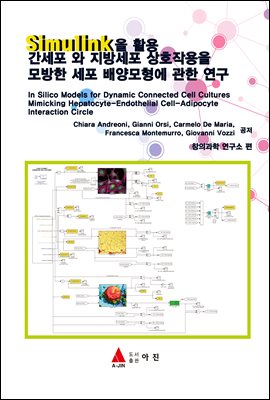
간세포 와 지방세포 상호작용을 모방한 세포 배양모형에 관한 연구
- 저자Chiara Andreoni, Gianni Orsi, Carmelo De Maria, Francesca Montemurro, Giovanni Vozzi 저
- 출판사아진
- 출판일2020-07-13
- 등록일2020-12-21
- SNS공유


- 파일포맷PDF
- 파일크기9MB
- 공급사YES24
-
지원기기
PC
PHONE
TABLET
프로그램 수동설치
전자책 프로그램 수동설치 안내
아이폰, 아이패드, 안드로이드폰, 태블릿,
보유 1, 대출 0,
예약 0, 누적대출 5, 누적예약 0
책소개
The biochemistry of a system made up of three kinds of cell is virtually impossibleto work out without the use of in silico models. Here, we deal with homeostatic
balance phenomena from a metabolic point of view and we present a new
computational model merging three single-cell models, already available from our
research group: the first model reproduced the metabolic behaviour of a
hepatocyte, the second one represented an endothelial cell, and the third one
described an adipocyte. Multiple interconnections were created among these three
models in order to mimic the main physiological interactions that are known for
the examined cell phenotypes. The ultimate aim was to recreate the
accomplishment of the homeostatic balance as it was observed for an in vitro
connected three-culture system concerning glucose and lipid metabolism in the
presence of the medium flow. The whole model was based on a modular approach
and on a set of nonlinear differential equations implemented in Simulink, applying
Michaelis-Menten kinetic laws and some energy balance considerations to the
studied metabolic pathways. Our in silico model was then validated against
experimental datasets coming from literature about the cited in vitro model. The
agreement between simulated and experimental results was good and the behaviour
of the connected culture system was reproduced through an adequate parameter
evaluation. The developed model may help other researchers to investigate further
about integrated metabolism and the regulation mechanisms underlying the
physiological homeostasis.
목차
제 1편 : SIMULINK 기본편1.1 SIMULINK의 시작 1
블록의 연결 5
블록 파라미터의 설정 7
시뮬레이션 파라미터 (Configuration Parameters)의 설정 8
시뮬레이션의 수행 9
블록 파라미터의 표시 9
복수 데이터의 표시 11
2.2 동적 시뮬레이션 13
이차 미분방정식 17
선형 상태변수 모델 23
DC 모터의 시뮬레이션 24
함수 블록의 사용 29
차분방정식(difference equation)의 모델링 34
Subsystem(부시스템)의 구성 37
제 2편 : 연구논문
In Silico Models for Dynamic Connected Cell Cultures Mimicking
Hepatocyte-Endothelial Cell-Adipocyte Interaction Circle
1. Introduction 41
2. Materials and Methods 45
3. New and Specific Metabolic Pathways Introduced 53
4. Validation Procedure 57
5. Results and Discussion 60
6. Conclusions 68
7. Supporting Information 69
8. References 70

















